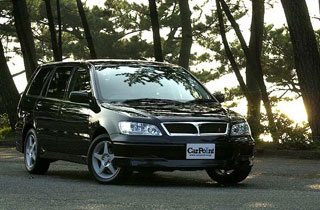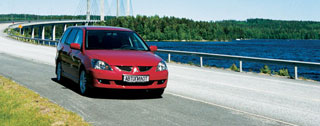Test drive Mitsubishi Lancer Evolution VIII 2003 - 2005 sedan
The triumph of pragmatism
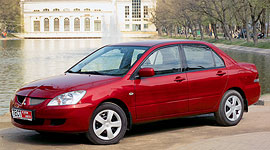 Against the background of many modern competitors, Mitsubishi-Lenser looks like a gray mouse, not particularly standing out. But at the same time, it regularly occupies the upper lines in the rating of popularity. The reason is a purely pragmatic very profitable ratio of price and consumer qualities.
Against the background of many modern competitors, Mitsubishi-Lenser looks like a gray mouse, not particularly standing out. But at the same time, it regularly occupies the upper lines in the rating of popularity. The reason is a purely pragmatic very profitable ratio of price and consumer qualities. There are cars in the golf class that buy by conviction. For example, Audi-A3 for prestige, Alfa-Romeo-147 for a bright character. Lancer at first glance is not impressive. Only one who knows that this is one of the few Japanese classmates assembled in Japan can buy it by conviction. And that the car of the Japanese brand and the car made in Japan is not the same thing. But there are few such advanced buyers. For most people, its price is the main argument in favor of Lancer.
What is the price?
More precisely, it became. Until recently, in the ratio of price/equipment, Lancer was an unconditionally most profitable offer in the class among all European and Japanese cars. But by the time of the release of this number, dealers will receive orders for Lancer in the 2005 model year, which became more expensive by $ 10001600 depending on the modification. In part, the increase in prices is explained by the general trend in their increase, partly expanding the list of pre -equipment. However, given that all the main competitors have recently rushed up, Lancer still remained with his own.
The price list for Lancer now begins with $ 15,490 for a 1.3-liter 82-horsepower sedan performed by comfort. However, this modest version of the weather does not make. It accounts for about 10% of Lancer sales.
The most demand is the Comfort-1,6 sedan for $ 16,490. A tempting, I must say, offer. European classmates at the current euro course can cost the same only as naked in configuration. Of the Japanese, only Nissan-Almer costs $ 1000. But there is no ABS in it. Even the Russian focus, if its equipment is adjusted to Lancer-1,6, will cost 13,500 euros (approximately $ 16,300).
Fulfillment comfort+ by $ 1340 more than comfort. But given the difference in the configuration, such an overpayment does not look overstated. Lovers of the hotter will surely pay attention to a 2-liter sedan performed by sports. You will not find another golf-class car with such an engine and emphasized by a sports image for $ 20,990.
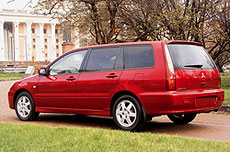
Since 2005 model year, 2-liter station wagons will be delivered in the sport version
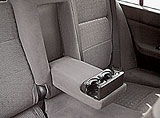
Distinctive features of the station wagon armrest with cup holders and adjustable inclination of the part of the back of the sofa
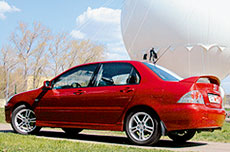
Already this fall, sport will receive a high suspension with a road clearance of 165 instead of 135 mm
The wagon of the 2005 model year will be offered with a 1.6-liter engine performed by comfort+($ 18,650) and with 2-liter in the sport version ($ 21,750). Universal Lancers are also beneficial. They cost only $ 760820 more similarly equipped sedans. And with competitors, station wagons are even more expensive.
The automatic gearbox is offered only with a 1.6-liter engine and adds $ 1160 to a price.
For the current meeting, we chose the most popular modification of the Comfort-1,6 sedan. And at the same time, we will introduce you to the 1.6-liter station wagon and a 2-liter sedan sport.
List of standard equipment
Sedan 1,3-combofors:
ABS with electronic brake force distribution
Frontary airbags
Adjustable steering column
Air conditioner
Front and rear electric windows
Electric drive of mirrors
central locking
Audio training
Adjustable driver's chair
Velor salon
Steel wheels
Tires 195/60 R15
1,6-compact in addition:
Heated mirrors
Heating the front seats
Mirrors and door handles in the color of the body
Adjustable tilt of the back of the back sofa (station wagon)
Rear armrest with cup holders (station wagon)
Roset 12 V in the trunk (station wagon)
1.6-compact+ additionally:
Front side pillows
Fog lights
Leather steering wheel
Plastic overlays on the thresholds of the body
Light alloy wheels
2.0-sport additionally:
Sports seats and steering wheel
Leather steering wheel finish, KP handles and parking brake
Tires 195/50 R16
Deep tinting of trunk glasses and rear doors (station wagon)
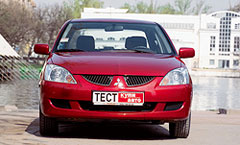 Outside and inside
Outside and inside Opponents of Lancer consider his appearance a faceless. Supporters say that the proportions of his body for the sedan are academically correct. But the fact of the matter is that in recent years the proportions of passenger sedans (as well as hatchbacks and station wagons) have become academically new. Their bodies grew up, as a result of which the waist line and the roof line increased, and the landing of the driver and passengers became more vertical. Take at least the focus, Corolla or Peugeot 307.
Lancer remained as the cars were ten years ago. Yes, and stylistic freshness in his design is not felt. And red fog lights, which were cut into the rear bumper, look at all greetings from the 80s.
And yet I do not agree that Lancer Beznik. In some angles, it is quite pretty, especially the station wagon. Another thing is that in Lanser there is no feeling of a new model. If you put restyled carisms next to him, it will not be sure to say that it was Lancer who replaced her, and not vice versa.
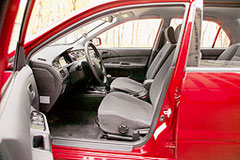
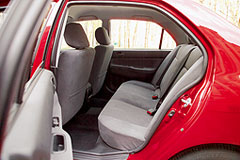
Inside the novelty is also not felt. The interior design is trivial. And the wide rectangular backs of the front chairs, I remember, were on Japanese cars in the early 90s. But if you discard the claims to originality, everything is very good. The doorways are wide, the cabin is quite spacious. Sitting at the back there is enough space in the legs and above the head. The chairs are not upholstered with fabric, as in many budget classmates, but by velor. The upper parts of the torpedo and upholstery of the doors are faced with soft plastic.
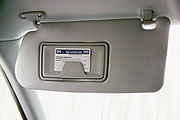
Cosmetic mirrors in both sunscreen visors are covered with lids with papers
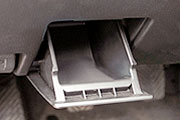
To the left of the steering column is a characteristic drawer for little things for Mitsubishi
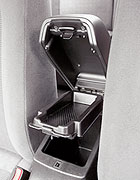
Under the lid of the front armrest are two boxes for small luggage
From the overall favorable picture, only deliberately cheap in the appearance of the steering wheel and glossy inserts under the black tree performed comfort. The latter imitate a polished tree no better than the green copper of gypsy sellers of gold. How more profitable compared to comfort is the SPORT SPORT with a sports wheel of MOMO and matte inserts for aluminum.
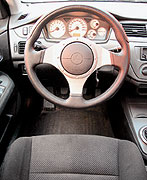
In the salon of a 2-liter version, Sports Momo steering, a sports dashboard and more embossed front seats
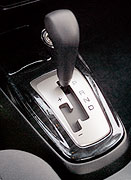
Automatic box with manual gear shift mode is offered only with a 1.6-liter engine
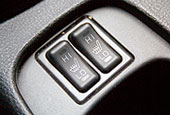
Two -stage heating of the seats Standard equipment of all Lancers with engines of 1.6 and 2.0 liters
By the way, in the station wagon, the rear sofa is equipped with a folding armrest with the cup holders and pushed 20 mm ago, which provides additional space. That's right, a modern station wagon is not just a barn for the transportation of a belongings, but above all a convenient passenger car.
Behind the wheel
Here it is a reckoning for academically correct proportions of the body. You do not sit in the low driver's seat of Lancer, but literally fall. Planting behind the wheel like in a sports car: the fifth point is almost on the floor, the legs are stretched forward. At this moment, attention should be paid. If you sympathize with Mitsubishi, but are already accustomed to a high, stool landing in carism or have problems with the musculoskeletal system, instead of Lancer, I would recommend that I look closely at the Space Star.
Ergonomics is typically Japanese. In the sense that he got behind the wheel and drove without preparation, as if he had traveled on Lanser before. All governing bodies are located and work very logically. I especially liked the microclimate control unit model of simplicity and clarity. The only drawback is too unit the upper part of the central console. Because of this radio with a large glossy display, as in our car, constantly glance. Therefore, when buying a radio for Lancer, it is advisable to choose a model with a small, drowned into a display.
The dashboard with semicircular dials, as in the Mercedes of the C-class, the designers of Mitsubishi probably spied on their owners from the Daimler-Core. But only the Japanese for some reason overloaded it with small risks. And in the right corner, despite the glass with a specially selected curvature, solar glare lives almost all the time. True, in this form, the tidy has been living the last days. Since 2005, a sports panel with round dials will appear on all the lanchers supplied to Russia, as in the modification of sports.
Governing bodies
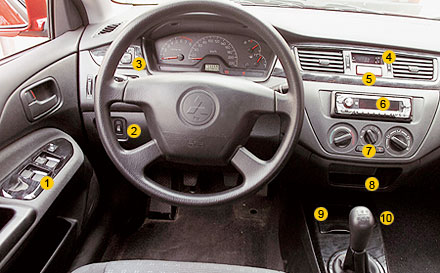
1. Block windows. 2. PEPRECTOR CENTER, regulator of brightness of the lighting of the devices. 3. The offset of the rear fog lamp, the mirror adjustment remote control. 4. Clock. 5. The alarm switch. 6. The radio (abnormal). 7. The ventilation and heating control unit. 8. Niche for fine luggage. 9. Ash. 10. Coicier.
Dashboard
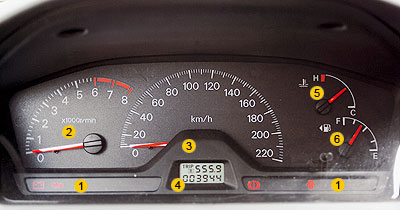
1. Block of control lamps. 2. Tachometer. 3. A speedometer. 4. Mileage counter. 5. The indicator of the temperature of the coolant. 6. Fuel level indicator.
But the steering wheel, for nothing that is large in diameter and cheap in appearance, lies in the hands of like a glove. And the seats were actually cool. If in carisms dense anatomical buckets are already convinced with their appearance of dignity, then in Lanser the convenience of wide, flat seats becomes an unexpected surprise.
I really liked the side mirrors. A rare car allows you to confidently maneuver in the stream without turning your head from the first minutes. The rear view is also not bad. True, provided that the central rear headrest is removed, which is almost never used, but overlaps the glass. By the way, in the sedan a rare case from the driver’s place is visible the edge of the trunk. Therefore, even in the absence of parking, you can maneuver in the parking lot quite confidently.
We load the suitcases
The declared volume of the trunk of the sedan is 430 liters. It's hard to believe. Many golf class sedans with equal or even less passport volume of chests will be deeper. In addition, the internal width of the trunk of Lancer is significantly limited by protruding wheel arches, and the loading height is large. When closing the lids, sickle -shaped loops go down and eat part of the volume, and the lid itself, as well as on many budget sedans, is devoid of the inner handle and upholstery (at the end of the year, there will be upholstery).
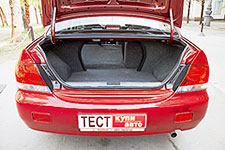
The opening between the trunk and the salon in the sedan is rather narrow
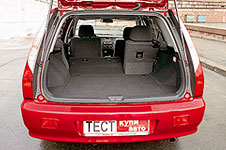
The horizontal roll curtain can be removed under the floor of the trunk
In the station wagon, there is a larger casket. Moreover, thanks to the almost vertical fifth door, the internal volume of the car is used to the maximum. The sofa transformation scheme is the same as in the sedan, only separate backs are folded, and the pillow remains in place. Because of this, the floor does not work perfectly, but if the right front chair is brought into the bedroom position, a loading platform from the rear door to a torpedo is formed. In addition, in the trunk of the station wagon there is a 12-volt rosette-gunner for connecting, say, a car refrigerator.
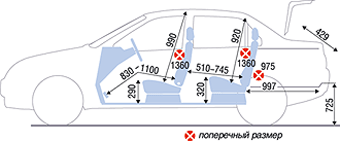
Salon dimensions, mm
Safety
At the time of preparation of the material, Lancer has not yet been subjected to independent crash tests according to the Euroncap methodology. Therefore, today you can only transfer passive safety funds with which the car is equipped. Most of them are standard for a modern golf class model. These are frontal pillows, protective bars in the doors and belts with a pretext and an effort limiter. The central castle, which is automatically unlocked when the pillows is triggered, deserves special mention.
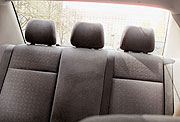
Massive rear head restraints significantly worsen the review. If you do not ride a five, it is better to remove the middle head restraint
We have no front side and window airbags in the lancers sold. However, as in most Japanese classmates. The Russian distributor Mitsubishi rightly believes that the mass buyer is not yet ready to overpay for additional pillows in the golf class.
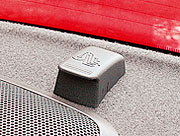
The brackets on the rear shelf are used to attach children's seats
For transportation of children, you can use an isofix standard chairs. The fastenings for them are regularly provided in the rear couch. But to install a children's chair forward in the front passenger seat is prohibited, since the right pillow does not turn off and can cause serious injuries to the child when triggered.
On the roads
We will lead the story about the riding qualities of Lancer in comparison with the carism. Because many representatives of the army of carism owners will be transplanted to its heir.
In terms of acceleration dynamics, Lancer is very similar to the predecessor. The first two programs are short, which allows you to shoot at the traffic light, and starting with the third, the box is stretched for the sake of economy. As a result, a sensation of dynamics is conceived in high gears, although in fact a 1.6-liter motor is quite frisky and painful. The fifth gear is simply supportive, and to get to overtake on a suburban highway, even the fourth has to twist the third. By the way, the transmission is selected in the same way from 2-liter sports, therefore it is not perceived by particularly aggressive. Consider this, failed street-players.
Another characteristic feature of carismation was an unjustifiably stiff suspension, which completely deprived the car of comfort, not providing in return for good controllability. Here, Lancer is similar to his predecessor only with stiffness, although he is still more comfortable. But in sled qualities it differs radically and for the better. If the carriage was working, then on Lanser it turned into pleasure. He holds the high -speed line and trajectory in corners much better. Lancer does everything correctly and predictably. As a result, the driver is less concentrated on the control process and, as a result, is less tired.
The fact is that the correct standard suspension of carisms, like many other cars, adapted for Russia without proper refinement of sled qualities. For Lancer, a unique case of the requirement of our market was recognized as priority (Russia reached fourth in Europe in terms of sales of Mitsubishi). Therefore, the designers had to initially lay an enlarged road clearance and muscles in the suspension. And already in this form to teach the car noble manners of behavior. Therefore, the result was completely different. Lancer rides better not only carisms, but also many other cars with a suspension adapted under bad roads.
Engine
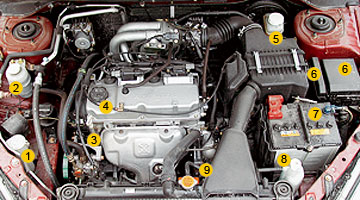
1. Glass washer tank. 2. Tanker of the steering wheel. 3. The oil probe of the engine. 4. The oil -stained neck of the engine. 5. The tank of the main brake cylinder. 6. Bloc of fuses. 7. Battery battery. 8. Expansion tank of the cooling system. 9. Radiator traffic jam.
And without them
Lancer’s good geometric cross -country ability is already felt in the city. For three days of crush in Moscow, I have never struck a bumper, parking my nose to the highest sidewalks. This is partly due to impressive, 165 mm, road clearance. But most importantly, Lancer has a form of bumper rare for modern cars, the lower edges of which, like my skiing, are lifted up.
Naturally, on a broken primer, Lancer allows you to feel confident enough. But this is already the merit of a hard short -flowing suspension, which does not allow the body to squat on irregularities, reaching to the ground. However, this medal has the opposite side. If on an even coating the hardness of the Lancer is not particularly noticeable, then on the pits the feeling is that instead of springs, wooden wedges drove into the suspension. On a broken road you have to go sneak, otherwise it shakes the whole soul. But still it is better than plowing a belly.
By the way, Lancer's bottom is quite flat. There is nothing special to tear there, and the lowest point is limited by a powerful longitudinal skiing under the engine. In principle, the motor crankcases and KP are located above this ski. But if you have to ride on broken roads, it is still better to establish steel protection.
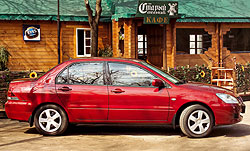 Operation, service
Operation, service The warranty on Lancer, as well as for most Japanese cars, is 3 years or 100,000 km of run. The frequency of planned is 15,000 km.
52 official dealers are engaged in the sale and service of Mitsubishi cars in Russia, of which 6 belong to the distributor of Rolf, the rest of the independent. However, the independence of dealers from Rolf is conditional. In those cities where Rolfa dealers work (in particular, in Moscow and St. Petersburg), the rest offer the same prices for work: $ 45 for operations included in the minimum mandatory volume and $ 55 for excess locksmithing. So the cheap 30-dollar service for Mitsubishi in Moscow and St. Petersburg cannot be found.
True, the level of service (in any case, in Rolfov technical centers) is quite high. It practices proprietary evacuation, if necessary, going to the house, special programs for working with corporate clients, etc.
Mitsubishi has no problems with supplying spare parts. In Moscow, a large regional warehouse operates, from which dealers regularly receive spare parts, and also organized operational (up to 15 days) delivery of missing parts. True, the prices for spare parts for Mitsubishi, as can be seen from the table, even by Japanese standards are high. This must also be taken into account if you are going to operate Lancer in the post -warranty period.
We liked
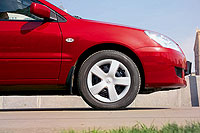
Large road clearance and high body overhangs
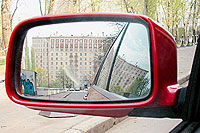
Great lateral mirrors
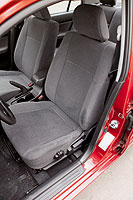
Comfortable front seats
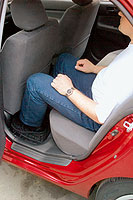
Spacious interior and convenient access to the rear sofa
And:
Driving qualities
Optimal equipment 1.6-compact
We didn't like it
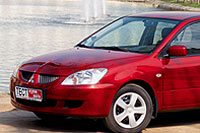
Lack of protective moldings on doors and bumers
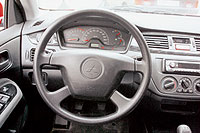
Cheap -looking steering wheel
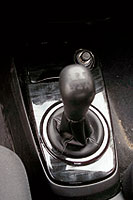
Unsuccessful imitation of a black tree
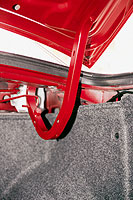
Trunk loops eat volume and think of the luggage
And:
Insufficient smoothness on broken roads
Lack of sensation of the new model
Dear spare parts
Mitsubishi Lancer 1.6
Total information
Body
5-seater sedan
Equipped mass, kg
1185
Complete mass, kg
1750
Speed, km/h
183
Acceleration time 0100 km/h, with
11.8
Fuel consumption, l/100 km highway/city
5.6/9.0
Fuel supply, l
50 (AI-95)
Engine
Location
Front transversely
Design
gasoline, 4-cylinder, in order, with one upper camshaft
The number of valves per cylinder
4
Diam. cylinder x Piston stroke, mm
76.0x87.3
Working volume, SMZ
1584
Compression ratio
10.0
Power, L.S. at rpm
98/5000
Torque, kgsm at rpm
15.3/4000
Chassis
Transmission
front -wheel drive
Transmission
Mechanical, 5-speed
Gear rates I; II; III; IV; V; Z.Kh.
3.58; 1.95; 1.34; 0.98; 0.8; 3.42
main gear
4.05
Suspension:
Independent, with stabilizers of anti -resistance stability
front
Type McEzerson
behind
Mollycent
Steering
REMENCH with an amplifier
Brakes
disk, in front, circular ventilated
Tires
195/60 R15
Prices for spare parts and that, $
TO1 (15,000 km) 167
TO2 (30,000 km) 240
TO3 (45,000 km) 172
Oil filter 10
Air filter 30
Spark plug (1 pc.) 5.7
Front belt 79
Front brake pads/rear 117/115
Tip of steering thrust 40
Steering rod 81
Ball support Lower (lever assembly) 255
Front shock absorber/rear 148/111
Front wing 217
Rear wing 422
Hood 402
Front door 600
The rear door is 600
Front bumper 410
Rear bumper 410
Windshield 316
Side glass 274
Front headlight assembly 436
Rear lamp assembly 158
We decided:
Mitsubishi-Lenser is really not amazing. This is just a good car at a good price. In our opinion, a decent recommendation.
Alexander Konov, photo of Maxim Goncharov
Source: Magazine buy a car [11/2004]






